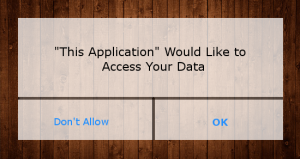
Due to the ever-growing population of smartphone and tablet users; mobile applications are now integrated into our daily lives. Sometimes when visiting our favorite websites, take Pinterest for example, we are immediately prompted to download an application from the Appstore. Without a second thought, we’ll tap through the installation process so we can view our content uninhibited.
Therein lies the problem.
App permissions and why they are important to you:
An application can ask for any number of permissions prior to installing itself onto your phone. Because our phones don’t have built-in firewalls, it is up to the user to keep their security in mind. There is a wide range of permissions that, if used maliciously, can steal any sensitive information from your device: passwords to accounts, credit card details, address book information, etc.
What do these permissions actually mean?
If you ever have a question as to what an Android app is asking for, you can check out Google’s definitions here.
iOS devices approach permissions differently by having a dedicated ‘Privacy’ menu and asking for permission only when needed. To review your current privacy settings; check out Apple’s guide here.
How can we be absolutely sure we’re downloading a ‘safe’ application?
Research. Applications that have a potential to steal data from your device can sometimes slip through security vetting/audits; prior to being available to download. If the app you are downloading seems questionable, use your favorite search engine to look up the name of the application, or the name of the developer. Likely, you’ll find several other users who have reviewed or openly discussed this application in a forum.
Next time you download an application, take a minute to review the permissions, you might be surprised at what you’ll find.

